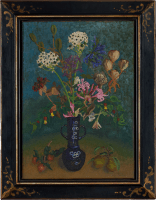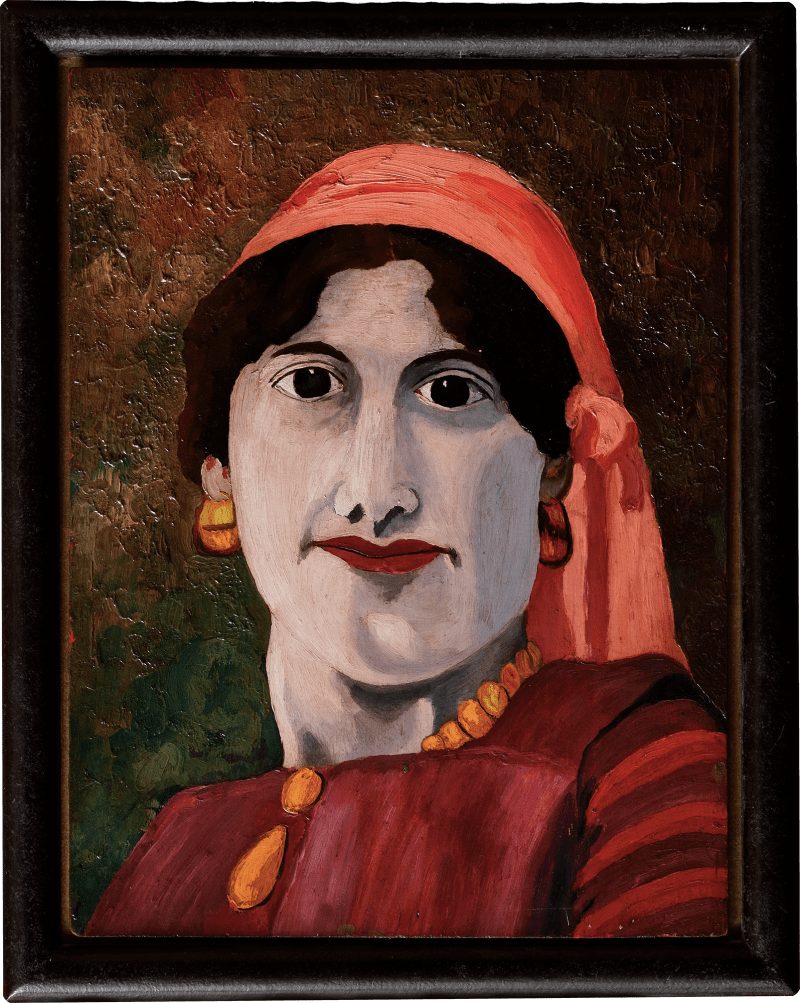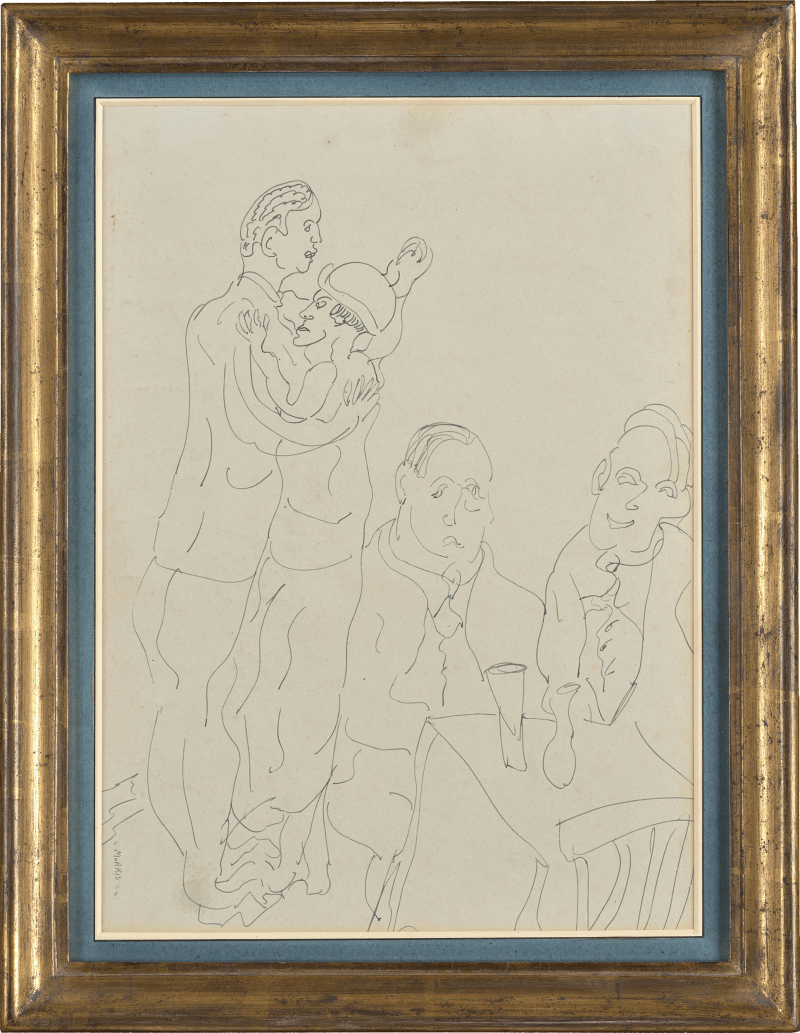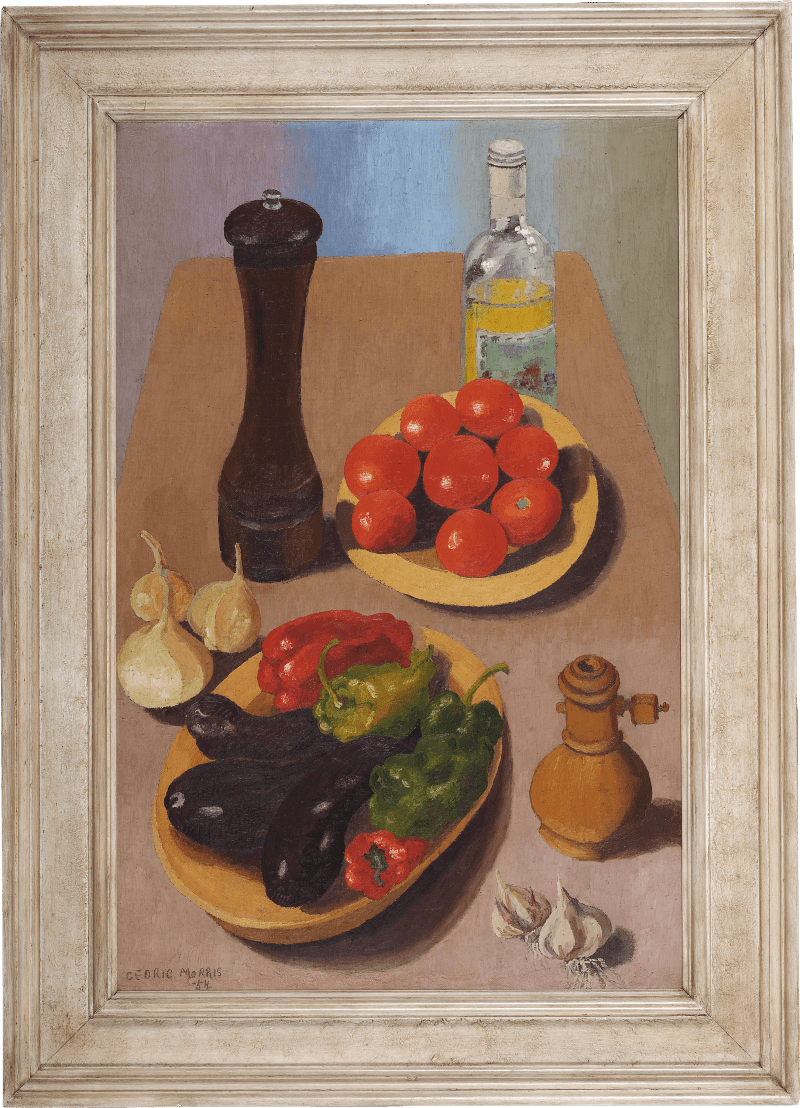Set against a gently receding backdrop of cool, forest green tones, this still-life depicts a cacophony of winter blooms all likely grown at the artist’s home, Benton End in Suffolk.
Cedric Morris cultivated a spectacular garden at Benton End, which has been heralded as one of the most interesting post-war collections of plants in Britain. Bursting with life, this still life is a celebration of his horticultural artistry.
This work was painted in 1959 when the turnover of students at Benton End’s art school (the East Anglian School of Painting and Drawing) was beginning to gradually reduce. As a result, Morris spent less time teaching and dedicated more time to his painting and gardening. By this date, Morris had firmly secured his status as an artist plantsman and would spend hours cultivating plants which he then painted with great care. Author and critic, Christopher Neve, rightfully attributes Morris’ artistic excellence to his unparalleled understanding of his subject matter:
It...
Set against a gently receding backdrop of cool, forest green tones, this still-life depicts a cacophony of winter blooms all likely grown at the artist’s home, Benton End in Suffolk.
Cedric Morris cultivated a spectacular garden at Benton End, which has been heralded as one of the most interesting post-war collections of plants in Britain. Bursting with life, this still life is a celebration of his horticultural artistry.
This work was painted in 1959 when the turnover of students at Benton End’s art school (the East Anglian School of Painting and Drawing) was beginning to gradually reduce. As a result, Morris spent less time teaching and dedicated more time to his painting and gardening. By this date, Morris had firmly secured his status as an artist plantsman and would spend hours cultivating plants which he then painted with great care. Author and critic, Christopher Neve, rightfully attributes Morris’ artistic excellence to his unparalleled understanding of his subject matter:
It has been the shared knowledge between Morris and his subject, and in particular, the mysterious way in which stiff paint could be made to catch a flower’s presence, that made the pictures painted at Benton End so memorable.[1]
By this stage in his career, Morris painted almost exclusively on canvas which possessed the necessary ‘give’ required for his technique; he applied his paint unsparingly, working in a series of small strokes horizontally, line by line. Millie Hayes, a student at the art school, recalled Morris advising students not to draw with paint but rather to ‘bounce’ with it across the canvas.[2] The background of this still life is particularly revealing of Morris’ distinctive technique, and it is this remarkable method that infuses Morris’ works with honesty and liveliness.
Each flower is imbued with a distinct personality, which is so well observed that horticulturalists can identify the exact species depicted by Morris in his flower paintings. In this still life, two tall Ornithogalum saundersiae tower over the composition, competing only with a few green iris seed pods. A dark blue Salvia and lighter purple Cardinal flower (Lobelia x speciosa) reach elegantly upward, and a bright pink Guernsey lily (nerine bowdenii) draws the eye down the canvas. Reaching outward and drooping both left and right are two branches of Trailing abutilon (abutilon megapoticanum) whilst another drooping Pink tobacco plant (Nicotiana) indicates down to the small branches of apples below the floral arrangement.[3]
This work was previously owned by Gerry Stewart, nephew of Morris’s partner Arthur Lett-Haines. Gerry was an occasional visitor to Benton End and at one stage contemplated moving there permanently to study at the art school. This was not to be and instead Gerry moved to the Middle East with his partner and ex-Benton End pupil Tony Daniells, returning some years later to help nurse Lett in his later years. Lett had visited Gerry and Tony in Beirut in the winter of 1958 and the present work was probably gifted to him soon after it was painted the following year. It was later acquired directly from Gerry by Felicity and Peter Wakefield, who had been introduced to each other by Gerry some years earlier in Jordan. Felicity had visited Benton End earlier in 1947 and later returned with her new husband for their honeymoon in 1951. Peter went on to lead a distinguished career as a diplomat and the Wakefields would regularly host Morris at their diplomatic residences when he was travelling around the Middle East.
[1] Neve, C. ‘A Painter and his Garden: Cedric Morris at Benton End’, Country Life, vol. 165 (4271), May 17 1979, p.1534.
[2] Morphet, R. Cedric Morris. London: The Tate Gallery, 1984, p.90.
[3] We are grateful to Clive Lundquist for identifying these species.













